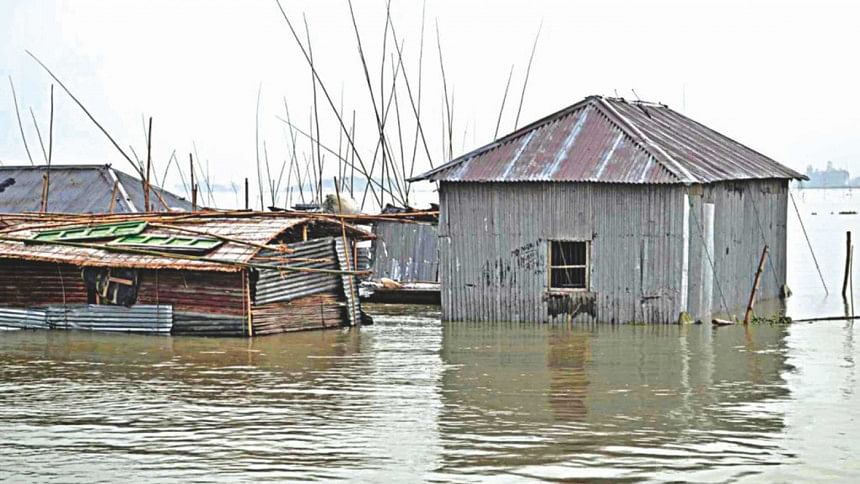Using our climate funds right

When I talk about Bangladesh's climate change response, I get excited by the thought of three milestones.
Regarding climate planning, I love to talk about Bangladesh Climate Change Strategy and Action Plan (BCCSAP). It was exclusively prepared by Bangladeshi climate change experts in 2008 (revised in 2009)—not to comply with any global agency, such as the United Nations Framework Convention on Climate Change (UNFCCC), but to meet the country's own needs. Over the last decade, this has been the sole guiding document to spend money from the Bangladesh Climate Change Trust Fund (BCCTF) and other funding sources, including the development partners.
I also get excited when thinking of the money we have been spending to face climate crisis. Eleven years ago, the BCCTF was established with the country's own money. Gradually, it became a pot of about USD 450 million, which until May 2021 supported 789 projects. According to the Climate Budget Report (2021-2022), Bangladesh's climate-related budget involving 25 ministries and agencies is USD 2.96 billion, which is 0.73 percent of the country's GDP. Between 2015-16 and 2021−2022, we doubled our climate budget. Despite the Covid-19 pandemic, the government continued allocating climate budget, which were 4.23 percent (2020-2021) and 4.16 percent (2021-2022) of the total national budget of two consecutive years.
Regarding our climate leadership in recent years, I love to highlight Bangladesh's current presidency at the Climate Vulnerable Forum (CVF) (2020-2022) and the opening of South Asia regional office of the Global Center on Adaptation (GCA) in Dhaka in September 2020. We are currently formulating Mujib Climate Prosperity Plan aiming at becoming a resilient upper-middle-income country by 2030. Many local, national and international NGOs, UN agencies, research organisations, networks, and individuals are working alone or in collaboration with national and international entities to improve the country's climate resilience. Bangladesh's proud legacy of community-based adaptation and nature-based solutions, like ecosystem-based adaptation, has made the country the "adaptation capital of the world," the "best teacher" in climate change adaptation, and an "adaptation leader."
But I don't feel easy talking about three aspects of our climate action.
First, the BCCSAP (2009) was meant for 10 years, but its updating began long before December 2018. Three years on, the government has yet to finalise and approve the revised BCCSAP. We have seen so many significant developments since the formulation of the BCCSAP in 2009—the ending of the Millennium Development Goals (MDGs) era (2001-2015), the beginning of the Sustainable Development Goals (SDGs) period (2016-2030), amazing success in poverty alleviation, and improvement in other development indicators (e.g. food security, child health, and primary education), leading to Bangladesh's graduation to the lower-middle-income status. Fulfilling "Vision 2021" encouraged the country to envision becoming a high-income country by 2041. The Bangladesh Delta Plan 2100 (2018) aims at transforming Bangladesh into a resilient delta. Although Bangladesh emits less than 0.35 percent of global greenhouse gas (GHG), according to the Nationally Determined Contributions (NDC, 2021), it proposed to reduce its GHG emissions by 6.73 percent (on its own) to 21.85 percent (with international support) by 2030. This commendable intention is in line with the Paris Agreement of 2015, where about 190 UNFCCC parties agreed to reduce GHG emissions to keep the global temperature rise below 2 degrees Celsius. Alarmingly, in August 2021, the Sixth Assessment Report of the Intergovernmental Panel on Climate Change (IPCC) drew an increasingly grim climate future for the vulnerable countries. Our inertia to consider all these domestic and international developments and update the BCCSAP to expedite climate action momentum is rather disappointing.
Secondly, the climate change trust fund (BCCTF) has funded hundreds of climate change projects, including formulation of strategies and action plans, like updating the National Conservation Strategy. However, the revision of the 2009 BCCSAP was not funded by the USD 450 million trust fund, but was supported by the GIZ, our German development partner. There must have been a fantastic reason behind such a decision made by the Ministry of Environment, Forest and Climate Change. Such dependency on foreign money continues, as the Environment Ministry is currently preparing the National Adaptation Plan (NAP) with the Green Climate Fund's (GCF) support. Throughout the 2000s and the 2010s, Bangladesh prepared many environmental and climate planning documents with foreign money—the BCCSAP was an exception. Should we still follow that old path because the money is there to use? Or, since we are meeting some international obligations by preparing those environmental plans, should international financiers pay us for these? Where did our sense of ownership and leadership go, which we had shown when we prepared the BCCSAP?
Thirdly, an analysis of the BCCTF allocations, as in Climate Budget Report (2021-2022), showed that the Ministry of Water Resources (132 projects), the Local Government Division (441 projects), and the Environment Ministry (68 projects) together implemented 88 percent of government agency-led projects. The average allocation per project ranged from USD 350,000 (LGD) to USD 900,000 (Ministry of Water Resources). On the other hand, the Palli Karma-Sahayak Foundation (PKSF) channelled USD 2.74 million of the BCCTF to 57 NGOs. It means, on average, each community-based climate change project received USD 48,000 as a grant. While we are proud of our country leading community-based climate actions, lots of small climate projects with small budgets indicate we are stuck with the notion of "pilot projects," while tens of millions of vulnerable people need large impactful climate programmes on a wider scale.
Speaking of large projects, back in 2018, the government listed 48 potential climate projects worth USD 3.17 billion in anticipation that 72 percent of this amount would come from the GCF. One project from that list received GCF's approval in November 2020, which will receive a USD 250 million loan to encourage private sector investments in the textile and ready-made garment industries for adoption of energy-saving technologies. For adaptation, the GCF has so far given Bangladesh about USD 60 million as grants, potentially reaching out to about 1.14 crore vulnerable people, i.e. investing nearly USD 5.3 in each person's resilience.
Significant funding deficit can also be seen in implementing a number of big climate-related plans. Out of 80 projects, for example, Bangladesh Delta Plan 2100 identified 34 projects as climate-relevant. According to Climate Budget Report (2021-2022), over the next couple of decades, USD 37 billion is needed to implement the first phase of this plan. Bangladesh hopes to receive a huge sum from the GCF (USD 2 billion annually), development partners, and private sector. Large investment gaps are also seen in achieving the adaptation and mitigation targets outlined in the NDCs. The current speed of channelling such large amount of fund is slow.
So, we know where we want to go in terms of climate resilience, how to go there, and how much money we need to make that journey. But, given the complex global climate funding mechanisms and the uncertainties owing to the Covid-19 pandemic, Bangladesh desperately needs to design and establish innovative and robust funding mechanisms. Can we have a national dialogue on this?
Dr Haseeb Md Irfanullah is an independent consultant working on environment, climate change, and research systems. His Twitter handle: @hmirfanullah

 For all latest news, follow The Daily Star's Google News channel.
For all latest news, follow The Daily Star's Google News channel. 



Comments